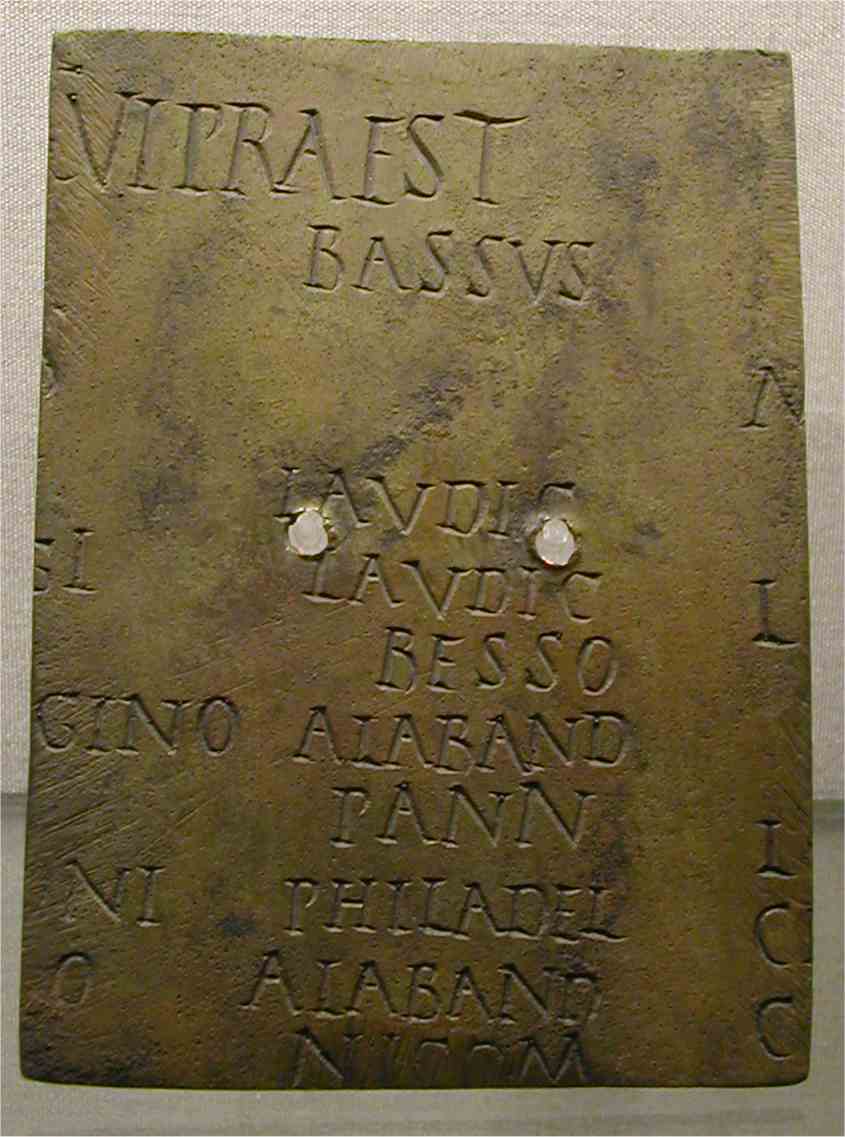 Possibly
the only surviving fragment of a constitutional tabula (re-used on the
other side as a military diploma later on), Weissenburg Museum, Germany
Possibly
the only surviving fragment of a constitutional tabula (re-used on the
other side as a military diploma later on), Weissenburg Museum, Germany
 Roman Military Diploma On-Line
Roman Military Diploma On-Line
Roman Military Diplomas / Diplomata (or better citizenship and/or military discharge certificates) are in some way the "greencards" of Roman times (green also being the dominating color of their bronze patina). Only that today you can win citizenship in a lottery. In Roman times foreigners had to serve for minimum 25 years (army) or 26 years (fleet) or longer in the auxiliary military forces (infantry = cohors, infantry mixed with light cavalry =cohors equitata, heavy cavalry = ala, fleet = classis, or pretorian cohors). In contrast the Roman legions (up to ca. 30 elite units mainly distributed along the borders of the empire, of ca. 5000 "legionaries" each) were reserved for Roman citizens. This distinction is thought to have lost its importance when Caracalla granted Roman citizenship in the early third century to all living in the Roman empire (except to the slaves of course), known as the Constitutio Antoniniana of 212 AD.
Roman Military Diplomas (more than 1000 are known to us and published to date) were/are found all over the Roman empire, mostly but not exclusively in the border provinces. As Diplomas show also the origin of the recipient, we can see that the middle and lower Danube region was a major recruitment area for non-citizens into the Roman auxiliary forces in the first and second century AD. While some veterans seem to have stayed close to their last place of service, many veterans - especially from the Danube region - seem to have returned to their home provinces after serving all over the vast Roman empire (we can conclude that from diplomas whose find spot is known). But there is no clear rule, a diploma could be found anywhere in the Roman empire, regardless of place of origin or service.
The massive barbaric invasions in the third century AD destroyed many Roman settlements, some never to be inhabited again, thus conserving diplomas that would otherwise have been melted down eventually for their metal value. Still only a fraction of < 1% of issued diplomas seems to have survived.
What is a Constitution ?
A constitution is a legal document issued by the Emperor in Rome. In case of Roman Military Constitutions the emperor granted Roman citizenship to specific veterans and their families, after a long and honorable service.
The
legal process is thought to have been...:
1) The office of the Commander of an auxiliary unit lists all
those soldiers of his ala or cohors ready for retirement or deserving
citizenship
2) He sends the list to the governor of his province
3) The provinical governor's administration bundles
all such requests for that province
4) and sends the list for this province to Rome
5) The imperial administration office in Rome draws up
an imperial constitution for that province to grant citizenship to all
the veterans on the list
6) The emperor personally approves and grants the
rights
7) A large bronze plate is written up listing all included veterans and
placed
publically in Rome (ie at the Minerva Statue
behind the Divus Augustus Temple)
8) Individual bronze copies (diplomas) are written
in Rome for each veteran with his name (possibly but not likely at cost
of the veteran)
9) The copies are checked, confirmed, wired, and
sealed by 7 witnesses
10) The diplomas are sent to the governor in the
province (more likely than sending them straight to the unit)
11) Diplomas for a specific unit are sent on from
the Provincial capital to the unit commander
12) The unit commander hands out the diplomas to the
veterans (likely in some sort of a ceremony)
We have published recently a diploma from an auxiliary constitution issued for only two veterans, a centurio and a horse soldier ! But mostly we are talking of veterans from anywhere between ca. 4 and ca. 25 auxiliary units, depending on the specific need of that province at that time. Sometimes more then one constitution was issued for the same province at the same date (split by units for logistical reasons ?). Thus potentially hundreds of soldiers at a time. Same for a praetorian fleet.
How many diplomas would have been issued for a given unit on a single date ? Let us take a regular cohors, 500 men, each serving 25 years. That would be 20 veterans each year assuming yearly recruitment (not always the case, see below) and no deaths (depends on circumstances). Or 40 in a milliaria unit of 1000 men. More real life scenarios show however that a major crisis like the Bar Kochba uprising caused major casualties, mass recruiting shortly after to fill the ranks, and multiple diplomas ie for the neighbouring province of Syria 25 years later. In similiar circumstances we know of 10 or more diplomas surviving of the same constitution indicating such a massive "bolus" of discharge.
A constitution could have covered thus between one and several hundred soldiers.
Constitutions are known to us only through their personalized copies = diplomas. Not a single of the large bronze plates from Rome survived. Below image shows a possible fragment of a constitutional tabula from Rome listing all the soldiers of a province that received Roman citizenship. It was re-used as a military diploma later on. (The "new" side with the diploma text not shown)
 Possibly
the only surviving fragment of a constitutional tabula (re-used on the
other side as a military diploma later on), Weissenburg Museum, Germany
Possibly
the only surviving fragment of a constitutional tabula (re-used on the
other side as a military diploma later on), Weissenburg Museum, Germany
How many constitutions do we know ? More than 400 Constitutions have been identified to date, with more than 1000 surviving individual military diplomas, some complete, but most in small fragments.
Which Units Received Citizenship Constitutions ? How many do we know ?
Constitutions cover mainly auxiliary forces and provincial fleets for non-citizen troops based along the the frontier. Survival of diplomas is more likely in provinces with many units - we only see a small fraction of what has been issued back then, maybe as little as 0.3 %, which is not surprising considering that bronze was a valuable and easily re-usable resource. For example we know more constitutions for Moesia (inferior and superior), Pannonia (inferior and superior), Dacia, Raetia, Germania, Britannia, and Mauretania Tingitana than for provinces with only small military presence such Thracia or Sardinia.
Constitutions are also known for the praetorian cohorts, the emperor's horse guard, and for the praetorian fleets in Ravenna and Misene. Below two graphs showing all known Roman citizenship constitutions as of December 31, 2014, first for the provinicial auxiliary forces incl the Equites singulares, and in the second graph the Fleets, the Praetorian and Urban Cohorts:
Known dated Roman Citizenship Constitutions per Roman Province (often with multiple surviving military diplomas)
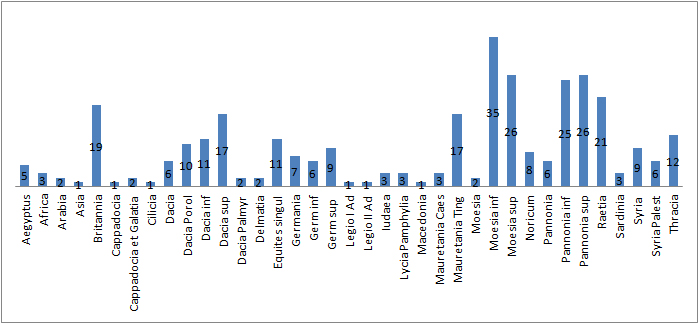 as of Dec 31, 2014
as of Dec 31, 2014
Known dated Roman Citizenship Constitutions per Roman Fleet, Praetorian Cohort, Equites Singulares, Urban Cohort (often with multiple surviving military diplomas)
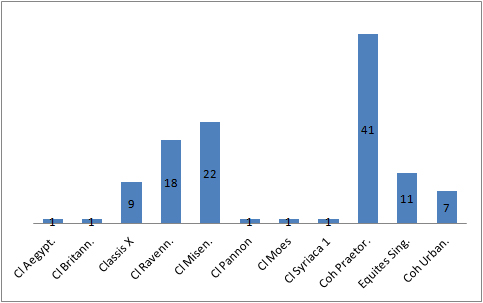 as of Dec. 31 2014
as of Dec. 31 2014
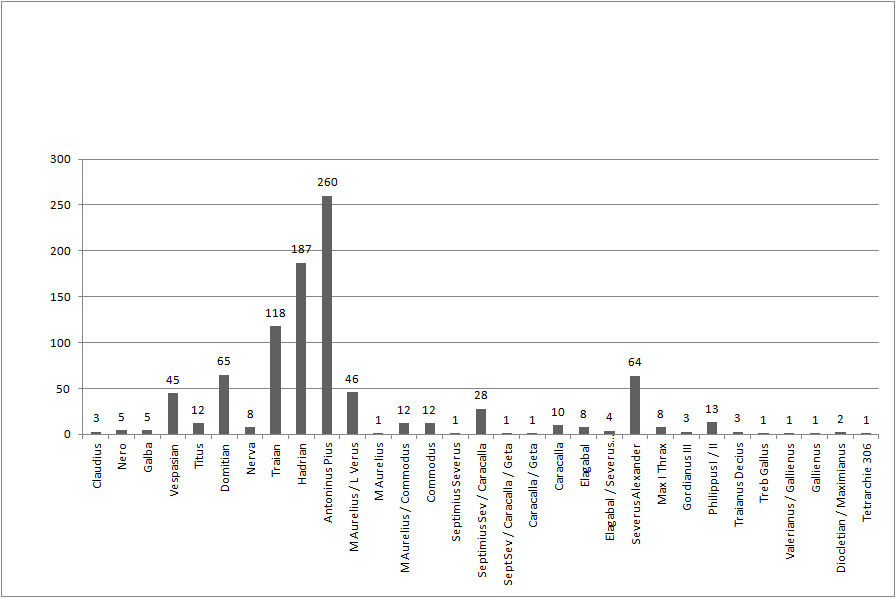
as of 2007
What does a Roman Military Diploma look like ?
A complete diploma consists of 2 bronze plates of rectangular shape, between 10x12 and 21x16 cm depending on the period, with text on both sides, bound together by bronze wire and sealed with witnesses seals. The seals were covered by three bronze strips to protect them from mechanical wear.
Below a typical diploma, unwired and opened up, with preserved witness seals and their protecting metal cover (closed and opened). This particulary well preserved example was found in Slavonski Brod and had been issued under Vespasianus.
The outer side of the so called tabula 1 holds a copy of the complete text. The outer side of tabula 2 (right) lists the seven witnesses and holds the seals.
(The images below are from the Slavonski Brod Website).
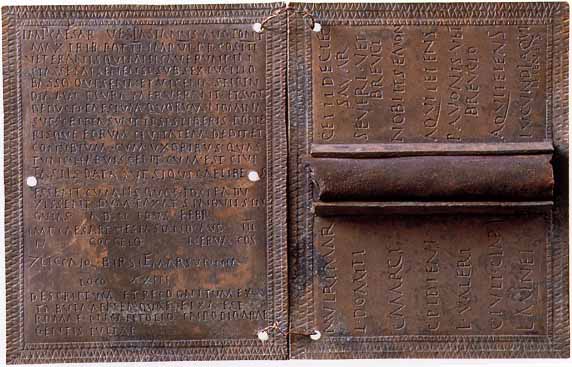
Below
image shows the seals exposed
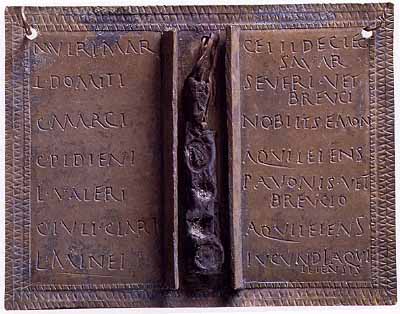
The two inner sides of the two tabulae
together reflect the outer text of tabula I, sometimes abbreviated and
often the text is written less carefully than on the outer sides. There
is the hypothesis that the actual copy of the Constitution in Rome is
the
inner - protected and sealed - text, while the outer text was for daily
use. The fact that the inner text got more and more neglected shows
that
this seems to have been forgotten over time, maybe because the inner
text
was rarely ever exposed
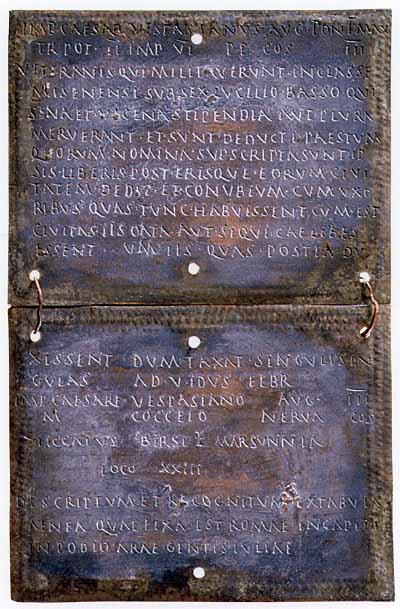
Another complete auxiliary diploma,
still wired together (seals and their cover are lost)
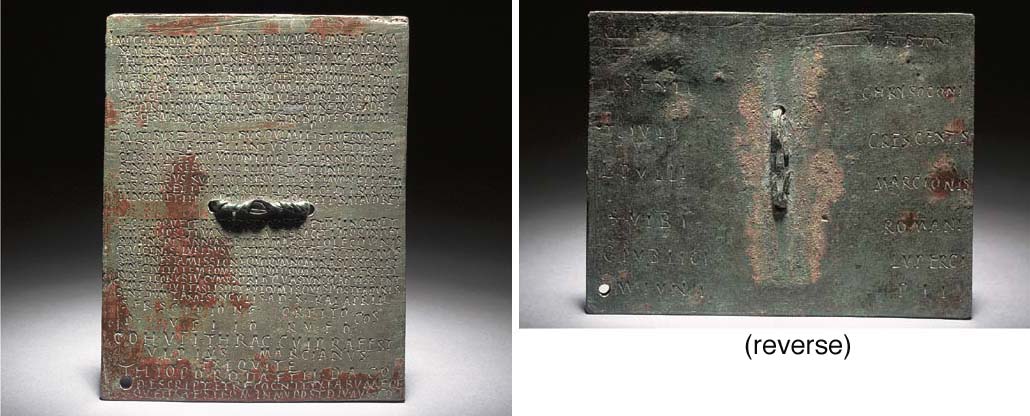
From MARCUS AURELIUS & his son
COMMODUS, 23 March, 178 A.D., under the consulship of Sergius Scipio
Orfitus
and P. Velius Rufus, Britannia under the governor Ulpius Marcellus, to
the cavalryman Thiophorus, a Dacian of the VII Thracian cohort, under
the
command of Ulpius Marcianus. (from the Axel Guttmann collection)
Why twice the same text ? The outer side was for daily use. If there was any suspicion of fraud, Roman provincial officials could break the seals and compare the outer with the inner text, compare for manipulations without having to wait for confirmation from far away Rome. Suetonius describes this practice for important documents in the Nero text of his 12 Caesars Book.
The thickness and weight of diplomas differs considerably, as does their size. Early and late pieces are usually thicker and heavier, and more carefully written. Under Antoninus Pius, with the quantity of known diploma reaching a peak, the quality seems to have deteriorated. Late diplomas are occasionally made from pre-used bronze plates, the original text still being visible in traces.
Diplomas were handed out to the veteran in his province as proof of his honorable service, his newly granted Roman citizenship for himself and his children. One cannot rule out that the veteran had to pay for his bronze diploma, and that not all veterans were willing or able to do so. But there is no indication at all that this may have been the case. And considering the central importance of the army and the fact that this privilege was given after a lifetime of honorable service, I personally see no reason not to believe the emperor took care of the cost for bronze. Still the fact that we find more diplomas for horse soldiers - presumably better paid - could be indicative for this hypothesis. But maybe horse soldiers simply had a better chance for survival ?
What is the Legal Text ?
All diplomas follow the same scheme, with sectors of standard legal text and sectors with individualized text.
Structure of the text:
Imperial titles defining the Emperor and the year of his reign - The imperial title are though to reflect the moment of the imperial decree:
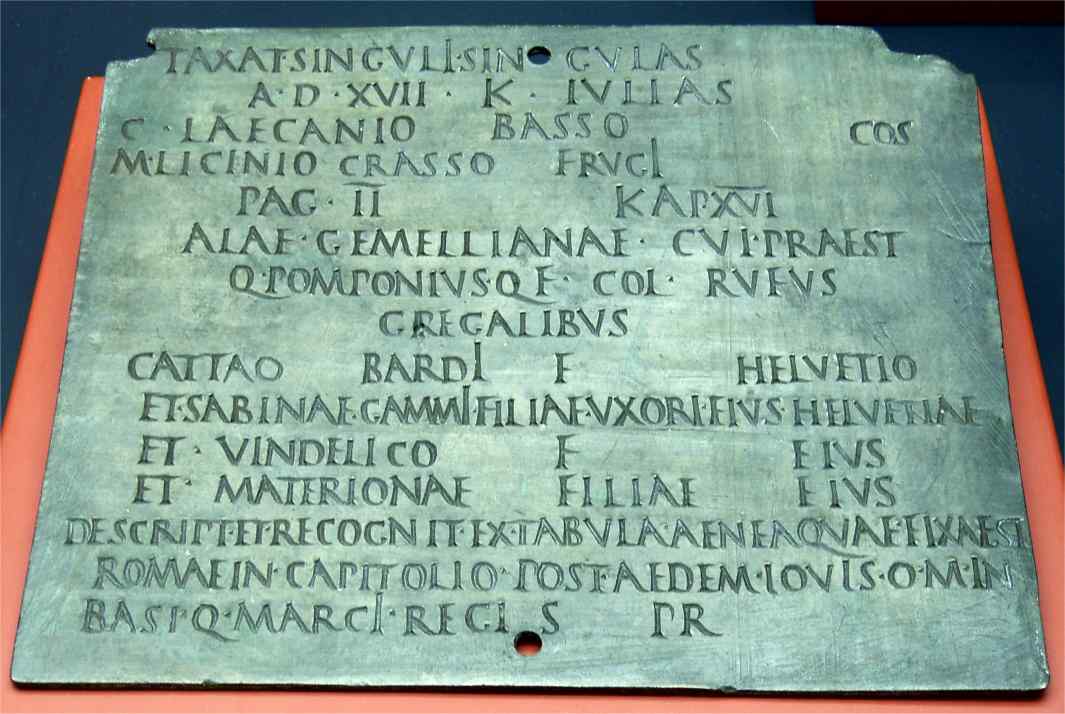
The
date (day and month) and the year are defined
by the two consules - though to reflect the day of issue of the
diploma:
Ie in the above example A D XVII K IVLIAS,
C LAECANIO BASSO, M LICINIO CRASSO FRVGI COS
Praetorian,
Urban Cohorts, Equites Singulares (Imperial Horse Guard), Legio I and
II
Adiutrix Diplomas:
Similiar to above, just that the single unit named
is one of the the pretorian cohorts or another Italian based unit.
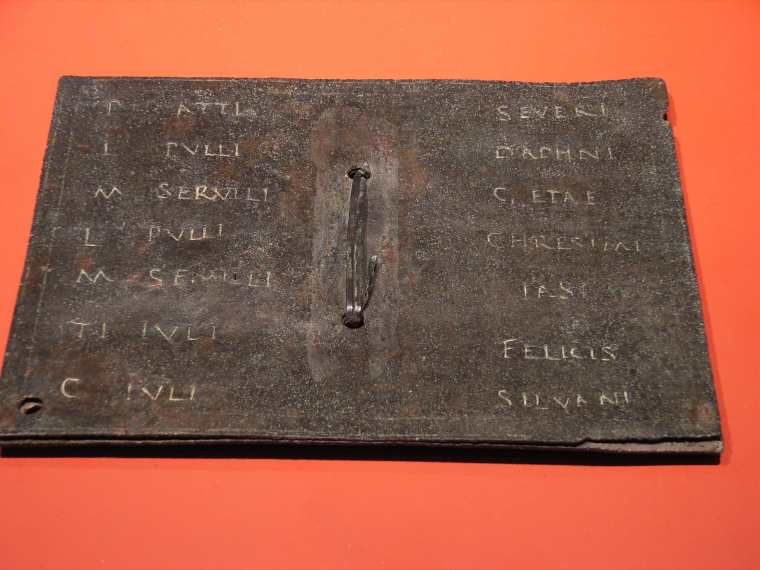
Another still wired diploma, shown
is the side with the witnesses (Munich Archeological Museum)
What was the Importance of the Diploma for the Veteran's Family ?
Auxiliary diplomas from Claudius to the early 140s also name the veterans wives and kids if they had any and the legal text covers not only the veteran, getting Roman citizenship, but also his family.
Legal constraints need to be considered here:
Children to such an inofficial relationship were only named on diplomas until ca. 140 AD, afterwards only children born after the military service were included in the legal text (but of course were born too late to be named on the diploma). As exception to the rule we still -rarely- find diplomas with special legal formulas that continue to name wives and kids, but only for officers (centurios or decurios) with families they had "registered" with the governor before they entered service. After their service they then got the privileges and the kids were named on the diploma. There is strong evidence that this privilege was not always restricted to officers, but also offered to common soldiers. Not many cases though, most common soldiers will have been too young anyway when enlisting to have qualifying families.
And we know of at least one diploma where Roman citizenship was also granted to the parents and siblings of the soldier (the soldier continued service as Roman citizen to complete his 25 years), but no wives and kids are mentioned - Eck & Pangerl, Chiron 33, 2003, 347ff
Questions that remain are:
1. Why
were children no longer included after 140
AD ?
2. Why did diplomas continue beyond the widening
of the Roman citizenship under Caracalla for Praetorians and Praetorian
Fleets, but not for Auxiliary soldiers ?
3) How about the Roman citizen soldiers serving
in the Legions ?
To question 1 we can assume that the number of such children may have increased substantially, and maybe Antoninus Pius simply wanted to clarify situation unfair to the Roman legions, citizen soldiers for whom we are not aware they got the same privilege of legalizing their inofficial mistresses and offspring (see question 3).
To
question 2 there is no 100% satisfying answer.
Why would Praetorians, and fleet or auxiliary soldiers
already Roman citizens (either by birth or after Caracalla's widening
of
the citizenship in 212 AD) still benefit from a military diploma
?
If they married a Roman citizen girl, they certainly had no need for a
diploma.
During the 1st and 2nd centuries - before the wider
impact of citizenship grants to veterans created a sufficient supply of
women with Roman citizenship even in the remotest limes areas - a
soldier
was likely to marry a non-citizen woman, a foreigner or a freed slave
woman. And as we learned above Roman
citizens could not have a formal marriage with non-citizens, and their
children
did not enjoy the full status of a Roman born. Thus as long as there
are non-citizen women to marry, a diploma would make sense, at least
for some.
The termination of auxiliary diplomas around 203
makes somewhat sense in this context. Soldiers could marry during
Septimius
Severus, and all free inhabitants of the Empire became Roman citizens
anyway
during Caracalla. All men were Roman citizen anyway, and there were no
more foreign
women to marry. So far so good.
But auxiliary diplomas became already increasingly
rare already much earlier - after Antoninus Pius (see graph above). And
we still find Praetorian and fleet diplomas after 212 AD. Actually more
than ever. Most Praetorian and Fleet diplomas we know of were issued
after
Septimius Severus / Caracalla and fall under this paradox. Why would
veterans
still want a diploma ? Honor ? Still for their foreign wives from
outside
of the Roman empire ? Or were the Praetorians of that period we know of
mostly coming from outside the Roman borders ? No, most were
born
in cities in the balkans, from inside the Roman empire. Hard to explain
!
There must be a reason for this we can only speculate
about. Maybe we misunderstood the widening of the citizenship under
Caracalla and it was much more restrictive
?
Thirdly
the question about the legionaries, all Roman
citizens, but who might have also enjoyed a marriage with a non-citizen
woman,
but who seemingly never got diplomas. And let us remember most legions
were also stationed at the borders
with a chronic undersupply of Roman citizen girls (see above). Still
the
only legionary diplomas we know are from the civil
war of 68/69 AD for soldiers of Legio I and II Adiutrix formed
out
of auxiliary non-citizen fleet soldiers, who needed to be quickly
"Romanized".
No good answer here either.
Why do we find so few diplomas ?
The
number of diplomas issued must have been in
the 100,000s over the centuries, but we have so far only found
fragments
of a good 1000, far less than 1 %.
Why ?
Bronze was a costly resource that could be readily
reused, either by melting it down as scrap metal, or by finding other
use.
Some examples below:
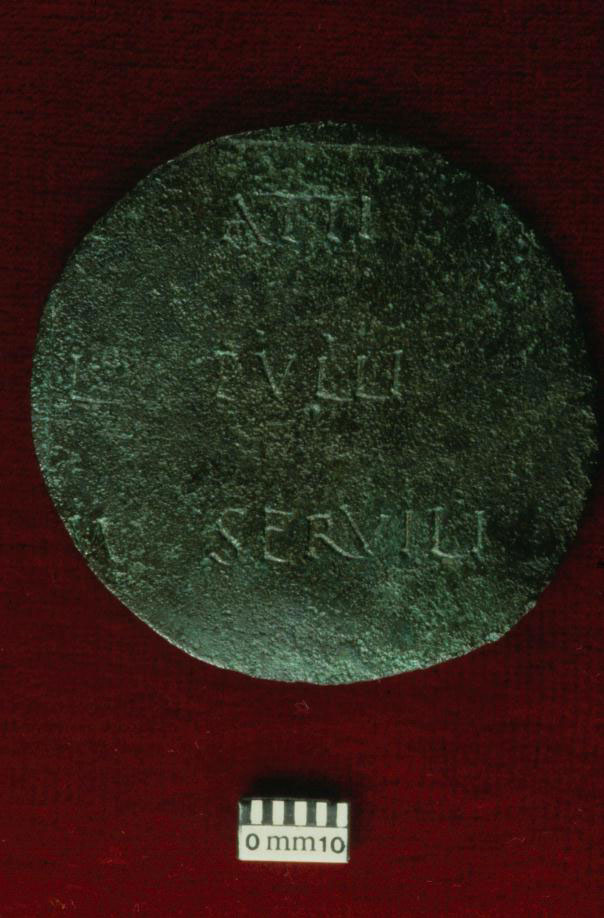
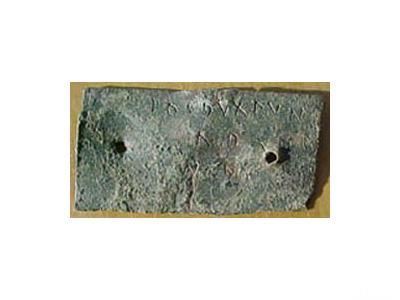
Not all that is bronze and carries a military discharge text is a citizenship diploma...
A Military Discharge Diploma
not granting citizenship and not
officially witnessed and sealed (likely private copies of official
documents in perishable materials such as wood/wax/paper)
under Philippus I and II, from the
RGZM Mainz, only one side with text, likely a private bronze copy of a
letter
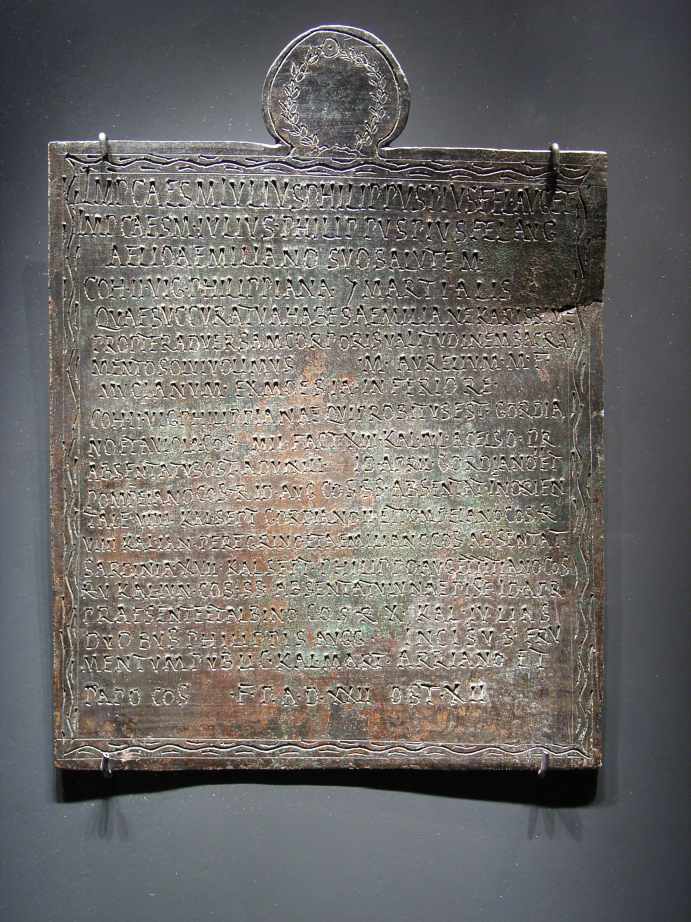
Dont' confuse a Military Diploma with other Texts on Metal Plates....
Curse Tablets
Lead
plate with curse, magic signs... Munich Archeological
Museum

Other Official Documents
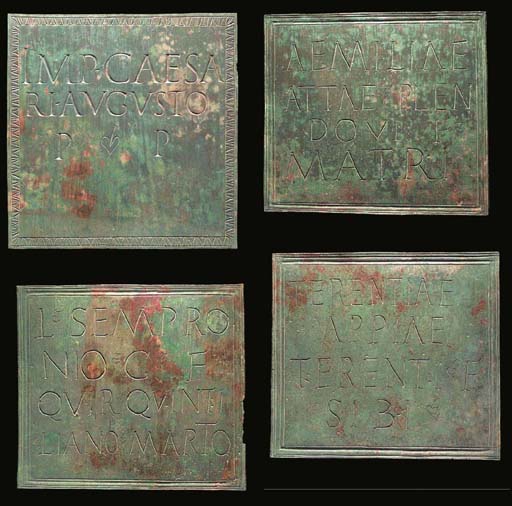
IMP(eratori) CAESA RI AUGUSTO P(atri) P(atriae)
AEMILIAE ATTAE PLEN DOVI F(iliae) MATRI
L SEMPRO NIO C(aii) F(ilio) QVIR(ina) QVINTI
LIANO
MARTO
TERENTIAE APPIAE TERENTI F(iliae) SIBI
(from the Axel Guttmann collection)